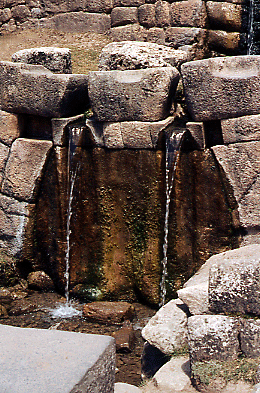If Glenn counts the time he traveled around the UK in the army during World War II, and U.S. sightseeing vacations with the family as the children grew up, it could be 60 years, but most of the foreign independent travel Betty and Glenn have done has been since 1971. Many of our friends now take cruises to South America to see Machu Picchu, Iguazu Falls, and other great sites there. That is easy, but they are missing a large part of the fun of foreign travel, and are getting only a brief peek at the sights available.
Reading travel books, studying maps, learning enough of the local language to get by, and planning the itinerary add so much to the enjoyment of the travel. Also, taking care of problems that arise adds to the fond memories.
Our first major foreign trip was in 1971 to South America, because we wanted to visit Wilma, a young Bogota woman for whom we had been a host family several years before. She had aroused our interest in Spanish culture and the language. Glenn had since studied Spanish at the adult high school, and that would make it easier to travel throughout Spanish speaking countries For later trips to Europe we would go to the library and take out “getting by in” French, German, etc. audio tapes to study, and later took a class in French at the local city college.
We fly PanAm from LA to Panama City, where we change planes for Bogota. After a nice visit with Wilma and her family, we fly on to Lima, then to Cusco (with an unforgettable overnight at Machu Picchu), then north to Quito before returning to Colombia.
One of the fun things about independent travel is surviving unexpected complications. Our flight from Cusco to Lima is late, so we miss our Air France flight to Quito. Rather than wait a week for their next flight, we are able the next day to get a flight to Guayaquil, and on to Quito. The last portion is in a 20 passenger plane with lots of windows and gourmet food, operated by the Equador army.
Avianca had an “Around Colombia” air fare, which we use to visit Cali, Santa Marta, Barranquilla, the San Andres Islands, and Cartagena before returning to Bogota. In Santa Marta we stay at a “native” hotel recommended by our Bogota friends. It is cheap, but clean. There is no air conditioning, but a ceiling fan over the bed to cool us off. The family running the hotel is very solicitous of our well being; when we take a taxi out to Concha Beach for a swim in the Caribbean, they instruct the driver to come back and pick us up, and tell us not to pay until the return trip.
A “must” visit in Santa Marta is to the home, now a shrine, where South America’s liberator, Bolivar, lived his last days.
The “around Colombia” towns are nice and warm after the cold weather of the high Andes. In Cali we are about the first guests at the just opened Hotel Intercontinental and have special attention from the lady training the staff. We tour the facilities being built for the Pan American games to be held there a few months later. There is still much work to be completed! There is no sign of drug trafficking and we walk the streets with no problems.
We take a taxi tour to Buga, 1 1/2 hours away, and spend an hour looking around this beautiful and clean Spanish-Colonial city.
San Andres fits our conception of an ideal tropical island, with reef offshore and white sand beaches studded with palm trees. Our hotel reservations aren’t valid, but the local housing agency puts us up in a nice apartment.
San Andres is a free port and most Colombians fly home with TV sets or other appliances on their laps. We find that Ballantines Scotch is cheaper than beer. We also find Hansa’s, a good sea food restaurant in a scenic spot over the water.
Barranquilla is a large industrial port city, but with many tropical trees, wide streets, and pretty residential areas.
In Cartagena we stay at the deluxe Hotel Del Caribe out on the beach. It is (then!) within our walking distance from the old town and we spend several days enjoying the fortifications and ancient buildings of the walled city, like the Plaza de las Coches.
Bogota is a modern city with high rise buildings and new residential areas. The premier attraction is the gold museum with pre-colombian gold artifices nicely displayed. We take the teleferrico to the top of Mt. Serrante for a view of the city and valley. We see the cathedral, art museum, main plaza with it’s statue of Bolivar, and attend a performance by Marcel Marceau in the elegant old Teatro Colon. Excursions outside of the city are to Guantavita, a showplace village relocated from a dam caused lake, and Zipaquira, a salt mine converted to a cathedral. All of these and more are shown to us by Wilma and her family while we stay in their home.
There is supposed to be political unrest and uprisings in Bogota while we are there, but we see none of it as we ride city busses and walk the streets with no trouble. A pick pocket tries to take Glenn’s wallet in a crowd in front of Sears, but is unsuccessful.
During our 1973 trip Wilma’s husband, Fernando, has migrated to Canada. On our way home from Brazil we come via Bogota and Wilma and her two children then fly with us to Sacramento and stay a while before joining him in Vancouver.
 GLENN & BETTY - BRUGGE 1994
GLENN & BETTY - BRUGGE 1994

















































